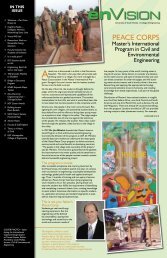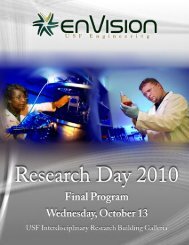envision - College Of Engineering - University of South Florida
envision - College Of Engineering - University of South Florida
envision - College Of Engineering - University of South Florida
You also want an ePaper? Increase the reach of your titles
YUMPU automatically turns print PDFs into web optimized ePapers that Google loves.
IMSE Adopts Comprehensive Mentoring:Coursework Won’t Do it Alone for IEsBy Janet DawaldExactly what is industrial engineering? Armies <strong>of</strong> dystopian robotsspewing sparks while a conveyor belt moves a perpetual river <strong>of</strong>mass-produced identical products? Come on, Blade Runner is thirtyyears old. The first department <strong>of</strong> industrial engineering in the UnitedStates, at Pennsylvania State <strong>University</strong>, opened its classrooms in1909, at a time when mass production dramatically lowered thecost <strong>of</strong> everything from automobiles to watches. But in the lastcentury, industrial engineering has evolved to keep pace not onlywith technology, but with humanity. Today, industrial engineers areconcerned with disease modeling and diagnosis, healthcare systems,big data analytics, energy, entertainment, logistics, and public policy.It is a multidisciplinary approach to improving complex systems,integrating both physical and social sciences to benefit mankind.Everyone involved in higher education, from freshmen to presidents,would agree that college is indeed a complex system. That is whyTapas K. Das, pr<strong>of</strong>essor and chair <strong>of</strong> the Department <strong>of</strong> Industrialand Management Systems <strong>Engineering</strong>, started applying the concepts<strong>of</strong> industrial engineering to his own department. Besides <strong>of</strong>fering aworld-class engineering education, Pr<strong>of</strong>essor Das is also dedicated toproviding his students with all the opportunities and experiences thata university such as USF <strong>of</strong>fers.“We went about this is a very deliberate way,” explains Das. “Ourstudents are attending a large global research university. It has somuch more to <strong>of</strong>fer than just the courses they sign up for. Ourstudents need to take advantage <strong>of</strong> these benefits now, because oncethey graduate and step out <strong>of</strong> the university, these resources mostlybecome unavailable.”The IMSE department had a strong tradition <strong>of</strong> mentoring. Butthe IMSE faculty, who are industrial engineers after all, wanted astandardized method that would introduce the students to a widerange <strong>of</strong> USF resources, activities and experiences. With Das’experience as an associate provost, the department faculty came upwith a mentoring program known as the Building Blocks for StudentPortfolio Development.On the surface, the portfolio appears to be a simple checklist.It is divided into Leadership, Community Engagement, Mentaland Physical Health, Language Competency, Global Experience,Undergraduate Research, Scholarships, and Life Skills. The IMSEfaculty divides the department’s students among themselves formentoring. Each student is presented with a standardized blankportfolio, and 45 minutes <strong>of</strong> one-on-one with a pr<strong>of</strong>essor in eachadvising cycle. Anticipating some blank stares, Das also provides aversion that is filled in with a range <strong>of</strong> possibilities available to USFstudents. For example, the Global Experience heading lists almost adozen suggestions, ranging in activities such as those organized by the<strong>Of</strong>fice <strong>of</strong> Multicultural Affairs all the way through to befriending oneinternational student. Leadership includes activities at the Center forLeadership and Civic Engagement (CLCE) all the way to working at<strong>Engineering</strong> EXPO.Prior to each semester, and before enrolling for classes, thestudents in this program fill out the portfolio with both goals andaccomplishments. The portfolio is saved in their folder, along withtranscripts. “When they come see us,” says Das, “we spend five orten minutes talking about classes, and then 30 minutes or more goingover the portfolio. What they accomplished in the past semester, andwhat their goals for the next semester will be.” Students are askedwhat their interests are, and receive information tailored to thosetopics. “If someone is interested in Hispanic culture, or Chineseculture, we refer them to both USF and community programs. Whenwe see you them the next time, we try to ensure that they havetaken full advantage <strong>of</strong> everything USF has to <strong>of</strong>fer.”Not every category needs to be done in every semester; planningis part <strong>of</strong> the learning process. The goal after two years is to have abalanced Portfolio that reflects not only engineering skills, but theexperiences that will make them stand out.The portfolio also serves several other purposes. “When you contactme for that letter <strong>of</strong> recommendation,” explains Das, “I am going tolook at your transcripts and your Portfolio, and I will write my letteron these two documents. It is up to you to build your Portfolio.”Obviously when your pr<strong>of</strong>essor can see that you volunteered toResearchNews<strong>College</strong> <strong>of</strong> <strong>Engineering</strong>Research Day 2012Dean Wiencek welcomed a group fromKangnam <strong>University</strong> in Yongin, <strong>South</strong> Koreathat participated in the 5th Annual <strong>College</strong><strong>of</strong> <strong>Engineering</strong> Research Day 2012. Picturedleft to right: Eung-ju Shin, Dong-Wook Shin,Dean Wiencek, Pr<strong>of</strong>essor Seung Ho Ch<strong>of</strong>rom Kangnam <strong>University</strong> in Korea andYoung-Hyun Lee. Eung-ju Shin and Young-Hyun Lee, students at Kangnam submitted:Laboratory <strong>of</strong> Fuel Cell Applications andAutomotive Electronics.8 enVision | November 2012For more information about Research Day 2012,use your smart phone’s QR reader.




